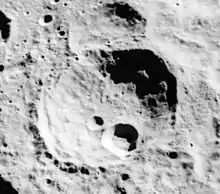Abul Wáfa (crater)
Abul Wafa is an impact crater located near the lunar equator on the far side of the Moon, named after the Persian mathematician and astronomer Abu al-Wafa' Buzjani.[1] To the east are the crater pair Ctesibius and Heron. In the northeast lies the larger crater King, and to the southwest is Vesalius.
 Apollo 16 Mapping camera image | |
| Coordinates | 1.0°N 116.6°E |
|---|---|
| Diameter | 55 km |
| Depth | 2.8 km |
| Colongitude | 244° at sunrise |
| Eponym | Abul Wáfa |


The perimeter of this crater somewhat resembles a rounded diamond shape. The rim and inner walls are rounded from impact erosion, and have lost some definition. There are ledges around most of the inner wall that may have once been terraces or slumped piles of scree.
A small but notable crater lies on the inner surface of the north rim of Abul Wáfa, and there is a small crater formation attached to the exterior southwest wall. The outer rim is relatively free of impacts, and the interior floor is marked only by a few small craterlets.
Satellite craters
By convention these features are identified on lunar maps by placing the letter on the side of the crater midpoint that is closest to Abul Wáfa.
| Abul Wáfa | Latitude | Longitude | Diameter |
|---|---|---|---|
| A | 1.4° N | 116.8° E | 16 km |
| Q | 0.2° N | 115.7° E | 30 km |
References
- "Abul Wáfa". Gazetteer of Planetary Nomenclature. USGS Astrogeology Research Program.
- Andersson, L. E.; Whitaker, E. A. (1982). NASA Catalogue of Lunar Nomenclature. NASA RP-1097.
- Bussey, B.; Spudis, P. (2004). The Clementine Atlas of the Moon. New York: Cambridge University Press. ISBN 978-0-521-81528-4.
- Cocks, Elijah E.; Cocks, Josiah C. (1995). Who's Who on the Moon: A Biographical Dictionary of Lunar Nomenclature. Tudor Publishers. ISBN 978-0-936389-27-1.
- McDowell, Jonathan (July 15, 2007). "Lunar Nomenclature". Jonathan's Space Report. Retrieved 2007-10-24.
- Menzel, D. H.; Minnaert, M.; Levin, B.; Dollfus, A.; Bell, B. (1971). "Report on Lunar Nomenclature by the Working Group of Commission 17 of the IAU". Space Science Reviews. 12 (2): 136–186. Bibcode:1971SSRv...12..136M. doi:10.1007/BF00171763. S2CID 122125855.
- Moore, Patrick (2001). On the Moon. Sterling Publishing Co. ISBN 978-0-304-35469-6.
- Price, Fred W. (1988). The Moon Observer's Handbook. Cambridge University Press. ISBN 978-0-521-33500-3.
- Rükl, Antonín (1990). Atlas of the Moon. Kalmbach Books. ISBN 978-0-913135-17-4.
- Webb, Rev. T. W. (1962). Celestial Objects for Common Telescopes (6th revised ed.). Dover. ISBN 978-0-486-20917-3.
- Whitaker, Ewen A. (1999). Mapping and Naming the Moon. Cambridge University Press. ISBN 978-0-521-62248-6.
- Wlasuk, Peter T. (2000). Observing the Moon. Springer. ISBN 978-1-85233-193-1.
